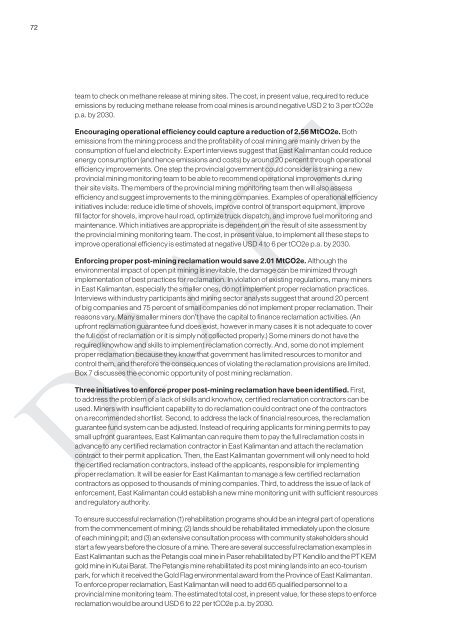East Kalimantan Environmentally Sustainable Development Strategy
East Kalimantan Environmentally Sustainable Development Strategy
East Kalimantan Environmentally Sustainable Development Strategy
Create successful ePaper yourself
Turn your PDF publications into a flip-book with our unique Google optimized e-Paper software.
72<br />
team to check on methane release at mining sites. The cost, in present value, required to reduce<br />
emissions by reducing methane release from coal mines is around negative USD 2 to 3 per tCO2e<br />
p.a. by 2030.<br />
Encouraging operational efficiency could capture a reduction of 2.56 MtCO2e. Both<br />
emissions from the mining process and the profitability of coal mining are mainly driven by the<br />
consumption of fuel and electricity. Expert interviews suggest that <strong>East</strong> <strong>Kalimantan</strong> could reduce<br />
energy consumption (and hence emissions and costs) by around 20 percent through operational<br />
efficiency improvements. One step the provincial government could consider is training a new<br />
provincial mining monitoring team to be able to recommend operational improvements during<br />
their site visits. The members of the provincial mining monitoring team then will also assess<br />
efficiency and suggest improvements to the mining companies. Examples of operational efficiency<br />
initiatives include: reduce idle time of shovels, improve control of transport equipment, improve<br />
fill factor for shovels, improve haul road, optimize truck dispatch, and improve fuel monitoring and<br />
maintenance. Which initiatives are appropriate is dependent on the result of site assessment by<br />
the provincial mining monitoring team. The cost, in present value, to implement all these steps to<br />
improve operational efficiency is estimated at negative USD 4 to 6 per tCO2e p.a. by 2030.<br />
Enforcing proper post-mining reclamation would save 2.01 MtCO2e. Although the<br />
environmental impact of open pit mining is inevitable, the damage can be minimized through<br />
implementation of best practices for reclamation. In violation of existing regulations, many miners<br />
in <strong>East</strong> <strong>Kalimantan</strong>, especially the smaller ones, do not implement proper reclamation practices.<br />
Interviews with industry participants and mining sector analysts suggest that around 20 percent<br />
of big companies and 75 percent of small companies do not implement proper reclamation. Their<br />
reasons vary. Many smaller miners don’t have the capital to finance reclamation activities. (An<br />
upfront reclamation guarantee fund does exist, however in many cases it is not adequate to cover<br />
the full cost of reclamation or it is simply not collected properly.) Some miners do not have the<br />
required knowhow and skills to implement reclamation correctly. And, some do not implement<br />
proper reclamation because they know that government has limited resources to monitor and<br />
control them, and therefore the consequences of violating the reclamation provisions are limited.<br />
Box 7 discusses the economic opportunity of post mining reclamation.<br />
Three initiatives to enforce proper post-mining reclamation have been identified. First,<br />
to address the problem of a lack of skills and knowhow, certified reclamation contractors can be<br />
used. Miners with insufficient capability to do reclamation could contract one of the contractors<br />
on a recommended shortlist. Second, to address the lack of financial resources, the reclamation<br />
guarantee fund system can be adjusted. Instead of requiring applicants for mining permits to pay<br />
small upfront guarantees, <strong>East</strong> <strong>Kalimantan</strong> can require them to pay the full reclamation costs in<br />
advance to any certified reclamation contractor in <strong>East</strong> <strong>Kalimantan</strong> and attach the reclamation<br />
contract to their permit application. Then, the <strong>East</strong> <strong>Kalimantan</strong> government will only need to hold<br />
the certified reclamation contractors, instead of the applicants, responsible for implementing<br />
proper reclamation. It will be easier for <strong>East</strong> <strong>Kalimantan</strong> to manage a few certified reclamation<br />
contractors as opposed to thousands of mining companies. Third, to address the issue of lack of<br />
enforcement, <strong>East</strong> <strong>Kalimantan</strong> could establish a new mine monitoring unit with sufficient resources<br />
and regulatory authority.<br />
DRAFT<br />
To ensure successful reclamation (1) rehabilitation programs should be an integral part of operations<br />
from the commencement of mining; (2) lands should be rehabilitated immediately upon the closure<br />
of each mining pit; and (3) an extensive consultation process with community stakeholders should<br />
start a few years before the closure of a mine. There are several successful reclamation examples in<br />
<strong>East</strong> <strong>Kalimantan</strong> such as the Petangis coal mine in Paser rehabilitated by PT Kendilo and the PT KEM<br />
gold mine in Kutai Barat. The Petangis mine rehabilitated its post mining lands into an eco-tourism<br />
park, for which it received the Gold Flag environmental award from the Province of <strong>East</strong> <strong>Kalimantan</strong>.<br />
To enforce proper reclamation, <strong>East</strong> <strong>Kalimantan</strong> will need to add 65 qualified personnel to a<br />
provincial mine monitoring team. The estimated total cost, in present value, for these steps to enforce<br />
reclamation would be around USD 6 to 22 per tCO2e p.a. by 2030.

















